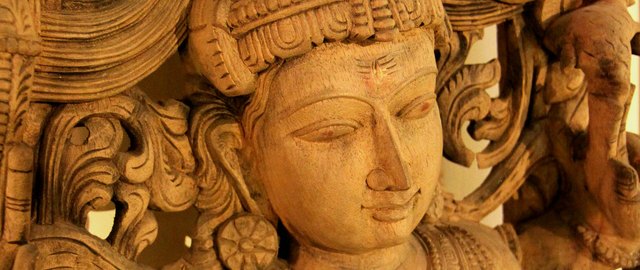
Chennai
After spending almost 4 months in Himachal and Jammu & Kashmir, Madhu and I desperately needed a change in scenery. Luckily, by the time we got done with Manali, Onam, one of Kerala’s biggest festivals, was round the corner. We took the opportunity to head south and spend the festival month celebrating with family, both immediate and extended, out there! Then a month became two and by the time we started planning our Kerala travel itinerary, most of the state was being barraged by thunderstorms and heavy rains. Not wanting to sit around waiting for the weather to improve, we packed up and flew off to Chennai, thus making Tamil Nadu the flag-off point of our South India tour!
Most Keralites feel quite connected with Tamilians as, apart from being geographical neighbors, our languages and food are somewhat similar. For me, personally, the connect is higher as many of my friends, especially those in the dance (Bharatanatyam) field, are Tamil. I have spent a generous portion of my life around them, listening to their language, understanding their culture and dancing to their lyrics and music (literally!); I was totally looking forward to touring the state! However, I also knew that this devout set of people, who are known to have been the first-ever Dravidian Indians, have built many temples throughout their land, which could lead to a state of being ‘templed out’ as we had been in Gujarat. Nevertheless, we knew it was going to be an interesting tour!
Chennai, being a port and the capital, is a large, bustling city segregated into different areas, each with its own little flavor. When Madhu and I flew in, we had no idea where to go but the guidebooks had suggested that the Egmore area would be a good place as it had quite a few budget-priced, stay options; so we headed there. After checking into our hotel, we decided that the best way to immerse ourselves into the local flavor was by watching the Tamil super-hero’s latest Tamil film, Endhiran in the theatres. So we decided to catch an evening show that day and hoped that the theatres would be relatively empty as it was a weekday. But then we forgot that it was, after all, a Rajni movie! The INOX multiplex theatre within the Ciy Center Mall was crammed with people and for a second Madhu and I panicked that we wouldn’t get any tickets. Luckily, we did and more than watching the movie (which was quite entertaining) we enjoyed the experience of being part of Rajni mania in Chennai!
Chennai Egmore area is centered around the Egmore station, which is one of the two major stations of the city, servicing connections to different parts of the state as well as to the neighboring states. It is also the place where  Chennai’s old port trade was conducted, which led to a maze of trading markets that still exist today! The area’s biggest attraction, though, is the sprawling Pantheon Complex, which houses a couple of museums and art galleries. Unfortunately, the place wasn’t as well-maintained as it should have been. The architecture of the various buildings within the complex seemed haphazard as the gorgeous British-era buildings had ugly, cement block appendages that may have been added later. Moreover, the path leading up from the main gates to the Bronze Gallery (where we headed foremost) was filthy and littered with both construction debris as well as general trash; we were terribly saddened!
Chennai’s old port trade was conducted, which led to a maze of trading markets that still exist today! The area’s biggest attraction, though, is the sprawling Pantheon Complex, which houses a couple of museums and art galleries. Unfortunately, the place wasn’t as well-maintained as it should have been. The architecture of the various buildings within the complex seemed haphazard as the gorgeous British-era buildings had ugly, cement block appendages that may have been added later. Moreover, the path leading up from the main gates to the Bronze Gallery (where we headed foremost) was filthy and littered with both construction debris as well as general trash; we were terribly saddened!
But none of this could stop us from enjoying the truly fantastic collection of Bronze sculptures that was on display. It was spread over 3 floors of an air-conditioned building. The first floor contained different poses and avatars of Lord Shiva and his family – Parvati, Ganesha and Murugan. All the items were placed within glass cabinets with an overhead light and a foot-note stating the name/avatar of the deity. The centerpiece Nataraja statue was absolutely delectable! The 2nd floor housed larger Nataraja idols and also those of Jainism’s Mahavira and Buddhism’s Buddha and Maitreya. A large Maitreya statue was my absolute favorite! The 3rd floor was dedicated to Lord Vishnu and his various avatars – a fabulous set of pieces. We took more than an hour to browse through all of these. Luckily, photography (for a fee) was allowed, so Madhu had a great time clicking away!
After the Bronze gallery, we walked around the complex and noticed that some reconstruction was on-going, which probably accounted for all the debris. Our next stop was at the Stone Sculpture Museum, which was housed in the ‘Front Building’ of the complex. Unfortunately, this was one of the older buildings therefore the museum hall was in poor shape with broken windows and poorly displayed sculptures. In fact, we were dismayed to see that the invaluable pieces from as far back as the 7th century were embedded into cement blocks to keep them standing. Some were just propped up against the walls or strewn on the floor. After seeing the Bronze Gallery, this was a complete let-down. Nonetheless, the sculptures were really beautiful and worth checking out.
Apart from a children’s museum, the complex houses two art galleries 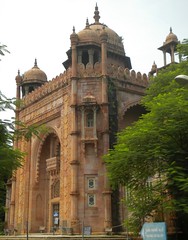 as well. Of these, unfortunately, the National Art Gallery was closed due to some renovation work. The building it is housed in is a lovely Victorian one; it looked absolutely grand from the outside! Next to it is the Contemporary Art Gallery, which is newly updated and very well laid out. On the 1st floor were informative displays on the state’s textile, metal and handicraft industry – their history onwards to current form. On the 2nd floor, which turned out to be our favorite, was a huge collection of Raja Ravi Varma paintings as well as those of other contemporary artists. Most of the work was simply amazing!
as well. Of these, unfortunately, the National Art Gallery was closed due to some renovation work. The building it is housed in is a lovely Victorian one; it looked absolutely grand from the outside! Next to it is the Contemporary Art Gallery, which is newly updated and very well laid out. On the 1st floor were informative displays on the state’s textile, metal and handicraft industry – their history onwards to current form. On the 2nd floor, which turned out to be our favorite, was a huge collection of Raja Ravi Varma paintings as well as those of other contemporary artists. Most of the work was simply amazing!
Chennai was the base from where Swami Vivekananda spread his message of peace and humanity to the rest of South India. In 1897, after his visit to the west, he visited Chennai and stayed for nine days in a bungalow by the beach, which was then known as the Ice House. Later the name was changed to Vivekanandar Illam when the Chennai branch of the Ramakrishna Mutt set up a permanent exhibition on Swami Vivekanand’s life and work in the bungalow. 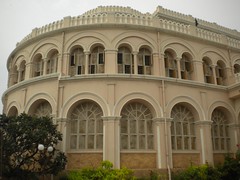 We visited this on our first day out in Chennai and found the Illam to be a beautiful structure on Beach road, which runs parallel to Chennai’s famous Marina Beach. Inside, we were charged a paltry Rs.2 per head to tour the premises, which housed photographs, paintings and informative displays on Swami Vivekanand. We spent a good hour here, including a few minutes inside a meditation hall, before leaving.
We visited this on our first day out in Chennai and found the Illam to be a beautiful structure on Beach road, which runs parallel to Chennai’s famous Marina Beach. Inside, we were charged a paltry Rs.2 per head to tour the premises, which housed photographs, paintings and informative displays on Swami Vivekanand. We spent a good hour here, including a few minutes inside a meditation hall, before leaving.
Right across the street from Vivekanandar Illam is Marina Beach, which is a major attraction in Chennai. Here we found most of the domestic tourists picnicking in the sand and (dangerously) frolicking in the waters. The beach is said to be 13kms long stretching all the way from Fort St. George (port) area in the north to the T Nagar area in the south.  We were also amazed by the width of the beach as it runs all the way to the edge of Beach Road, without any rocky enclosures. There were the usual hawkers and vendors hawking everything from food and plastic toys to horse rides. The newly built promenade, which borders the beach, has a large statue of Mahatma Gandhi and a couple of other historical figures relevant to the state.
We were also amazed by the width of the beach as it runs all the way to the edge of Beach Road, without any rocky enclosures. There were the usual hawkers and vendors hawking everything from food and plastic toys to horse rides. The newly built promenade, which borders the beach, has a large statue of Mahatma Gandhi and a couple of other historical figures relevant to the state.
A little south of the beach is the lovely, whitewashed,  Saint Thomas Basilica. This is a landmark in the state as it is built over the tomb of none other than St. Thomas, one of Jesus Christ’s 12 apostles! He came to this port city in AD 52 to spread the word of Jesus and was buried in AD72. There are only two other basilicas in the world that have been built over Christ’s apostles’ tombs: St. Peter’s in Rome,
Saint Thomas Basilica. This is a landmark in the state as it is built over the tomb of none other than St. Thomas, one of Jesus Christ’s 12 apostles! He came to this port city in AD 52 to spread the word of Jesus and was buried in AD72. There are only two other basilicas in the world that have been built over Christ’s apostles’ tombs: St. Peter’s in Rome,
Italy and St. James’ in Compestella, Spain. Behind the main church building is a small underground chapel where one can actually pray at the tomb. Pope John Paul II visited and prayed here in 1986. Above the chapel is a small exhibition area displaying artifacts relating to the church’s history and its renovation over the years. The interior of the main basilica was fabulous and gave us a few minutes of peace and calm, even though the church sits right by a very busy traffic junction.
Within walking distance from the church is Chennai’s famous 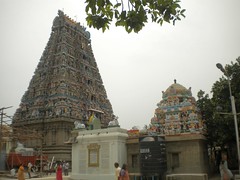 Kapaleeshwarar Temple, which falls within the Mylapore area. This was our first ever Tamil Nadu temple visit and we immediately recognized the colorful, multi-tiered Gopuram (temple gateway) that we’d seen in photographs of South Indian temples. Originally built in the 7th century by the Pallava dynasty, the temple complex is dedicated to Lord Shiva and his wife, Parvati in the form of Goddess Karpagambal. However, several architectural updates have been made to the temple over the years. Inside, the main shrine houses a Shiva Linga in a very atmospheric inner sanctum. We were able to get a good darshanam and walk around the temple complex in relative peace, in spite of the crowds.
Kapaleeshwarar Temple, which falls within the Mylapore area. This was our first ever Tamil Nadu temple visit and we immediately recognized the colorful, multi-tiered Gopuram (temple gateway) that we’d seen in photographs of South Indian temples. Originally built in the 7th century by the Pallava dynasty, the temple complex is dedicated to Lord Shiva and his wife, Parvati in the form of Goddess Karpagambal. However, several architectural updates have been made to the temple over the years. Inside, the main shrine houses a Shiva Linga in a very atmospheric inner sanctum. We were able to get a good darshanam and walk around the temple complex in relative peace, in spite of the crowds.
Just a couple of streets from the temple, is the fabulous Universal Temple of the Sri Ramakrishna Math. We got there around 2:30pm but the temple closes for the afternoon, reopening only at 3  So we walked over to the nearby courtyard of the Math, browsed their bookshop and then sat under the shade of a porch. There we met Mr. Kumar who lives in the suburbs of Chennai and was at the Math’s bookshop to look for a good book on the epic, Mahabharata. He was warm and friendly and took a lot of interest in our ‘travel’ story. He knew a lot about the state and we pestered him with questions on must-see places and things to do, to which he happily answered. We exchanged email IDs and he later emailed us an Excel sheet with his recommended list of places in Tamil Nadu! Thank you, Mr. Kumar – more than any place, it is people like you who have made our travels so special!
So we walked over to the nearby courtyard of the Math, browsed their bookshop and then sat under the shade of a porch. There we met Mr. Kumar who lives in the suburbs of Chennai and was at the Math’s bookshop to look for a good book on the epic, Mahabharata. He was warm and friendly and took a lot of interest in our ‘travel’ story. He knew a lot about the state and we pestered him with questions on must-see places and things to do, to which he happily answered. We exchanged email IDs and he later emailed us an Excel sheet with his recommended list of places in Tamil Nadu! Thank you, Mr. Kumar – more than any place, it is people like you who have made our travels so special!
The Ramakrishna Mission was started by Swami Vivekanand, who was the chief disciple of Sri Ramakrishna, a great 19th century sage. 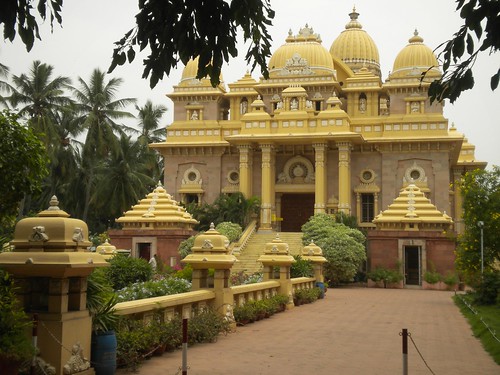 The mission believes in the oneness of all religions and therefore, has a Universal Temple that is dedicated to no particular deity or religion. The facade of the temple is like any ornate South Indian temple and is very impressive. Inside, the prayer hall is large but simple in aesthetics. It enshrines a 7ft tall, marble statue of Sri Ramakrishna. Devotees and believers meditate here, giving the hall a powerful but calm ambience. The temple stands in the center of a nicely landscaped courtyard and it was nice to walk around it, soaking in the atmosphere!
The mission believes in the oneness of all religions and therefore, has a Universal Temple that is dedicated to no particular deity or religion. The facade of the temple is like any ornate South Indian temple and is very impressive. Inside, the prayer hall is large but simple in aesthetics. It enshrines a 7ft tall, marble statue of Sri Ramakrishna. Devotees and believers meditate here, giving the hall a powerful but calm ambience. The temple stands in the center of a nicely landscaped courtyard and it was nice to walk around it, soaking in the atmosphere!
At the city’s southern end is the lovely Adyar area with its leafy streets and cute bungalows. Here, set in about 100hectares of land, is the Theosophical Society‘s Indian headquarters. 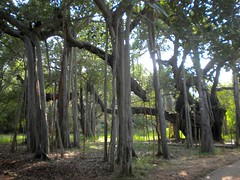 For some reason, none of the auto-rickshaw guys in Chennai seemed to know where it was and we had to hop a couple of autos before one driver tenaciously asked around and finally brought us to the right place. We were rudely welcomed by a security guard who seemed upset at us having disturbed his afternoon siesta. Then we were allowed to walk the grounds and explore the place at our leisure. The main attraction, for tourists like us, who have no interest in the theosophical aspect of the institution, is its green grounds and the world’s largest Banyan tree, which sits almost at the center of its grounds. En route to it, we saw a Zionist temple, a Lutheran church, a Gurudwara and a Hindu temple – a testimonial to the institution’s belief in all religions. But none of them seemed to be in use and the grounds around them were not maintained at all. The Banyan tree, though, was quite interesting with branches that had touched the ground to form tree trunks – it looked like several trees were conjoined together! Since the afternoon heat turned out to be a little uncomfortable we didn’t really enjoy the walk around the society’s groundswish we had gone there later in the day!
For some reason, none of the auto-rickshaw guys in Chennai seemed to know where it was and we had to hop a couple of autos before one driver tenaciously asked around and finally brought us to the right place. We were rudely welcomed by a security guard who seemed upset at us having disturbed his afternoon siesta. Then we were allowed to walk the grounds and explore the place at our leisure. The main attraction, for tourists like us, who have no interest in the theosophical aspect of the institution, is its green grounds and the world’s largest Banyan tree, which sits almost at the center of its grounds. En route to it, we saw a Zionist temple, a Lutheran church, a Gurudwara and a Hindu temple – a testimonial to the institution’s belief in all religions. But none of them seemed to be in use and the grounds around them were not maintained at all. The Banyan tree, though, was quite interesting with branches that had touched the ground to form tree trunks – it looked like several trees were conjoined together! Since the afternoon heat turned out to be a little uncomfortable we didn’t really enjoy the walk around the society’s groundswish we had gone there later in the day!
South of the Theosophical Society, on the road to Mamallapuram is the famed Kalakshetra Institute of dance and music. It’s one of India’s premier dance institutions and I had always had a desire to visit it and watch a class in progress or one of their productions on home ground. However, unfortunately, when we got there, we found that the academy was closed for Dassera and would reopen only a couple of weeks later. I was sorely disappointed! But I got a peek into the campus and it was all that I had imagined it to be. Simple, airy rooms set between trees were being used as classrooms and we even witnessed a group practicing in one of these rooms. We watched them for a few seconds, trying hard not to distract them in any way, and then left. Maybe I’ll get another chance someday to come and watch the dancers in leisure.
Unexpectedly, Chennai had a lot to offer in terms of sight-seeing. We were quite impressed!


No comments yet.